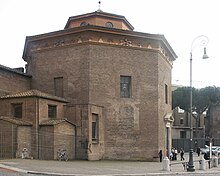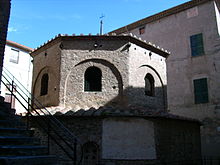Baptistery
In
was administered in the baptistery.Design

The sacramental importance and sometimes architectural splendour of the baptistery reflect the historical importance of baptism to Christians. Beginning in the fourth century, baptisteries in Italy were often designed with an octagonal plan.[1] The octagonal plan of the Lateran Baptistery, the first structure expressly built as a baptistery, provided a widely followed model. The baptistery might be twelve-sided, or even circular as at Pisa.[2]
In a
The Lateran baptistery's font was fed by a natural spring. When the site had been the palatial dwelling of the Laterani, before Constantine presented it to Bishop Miltiades, the spring formed the water source for the numerous occupants of the domus. As the requirements for Christian baptisteries expanded,
History

Baptisteries belong to a period of the church when great numbers of adult catechumens were baptized and immersion was the rule. They did not seem to be common before the emperors Gratian, Valentinian, and Theodosius made Christianity the state religion in the Edict of Thessalonica (i.e. before the 4th century). As early as the 6th century, the baptismal font was commonly built in the porch of the church, before it was moved into the church itself. After the 9th century, with infant baptism increasingly the rule, few baptisteries were built. Some of the older baptisteries were so large that there are accounts of councils and synods being held in them. They had to be large because a bishop in the early church would customarily baptize all the catechumens in his diocese and the rite was performed only three times a year, on certain holy days. Baptisteries were thus attached to the cathedral and not to the parish churches. In the Italian countryside a pieve was a church with a baptistery on which other churches without baptisteries depended.
During the months when no baptisms occurred, the baptistery doors were sealed with the

Though baptisteries were forbidden to be used as burial-places by the Council of Auxerre (578), they were sometimes used as such. The Florentine Antipope John XXIII (d. 1419) was buried in the Florence Baptistery, facing Florence Cathedral, with great ceremony, and a large and sculpturally important tomb by Donatello and his partner. Many of the early archbishops of Canterbury in England were buried in the baptistery at Canterbury.
According to the records of early church councils, baptisteries were first built and used to correct what were considered the evils arising from the practice of private baptism. As soon as Christianity had expanded so that baptism became the rule, and as immersion of adults gave place to sprinkling of infants, the ancient baptisteries were no longer necessary. They are still in general use, however, in Florence and Pisa.

The Lateran Baptistery must be the earliest ecclesiastical building still in use. A large part of it remains as built by Constantine. The central area, with the basin of the font, is an octagon around which stand eight porphyry columns, with marble capitals and entablature of classical form. Outside these are an ambulatory and outer walls forming a larger octagon. Attached to one side, toward the Lateran basilica, is a porch with two noble porphyry columns and richly carved capitals, bases and entablatures.
The circular church of
The earliest surviving structure that was used as a baptistery is the tomb-like baptistery at
In the East, the metropolitan baptistery at Constantinople still stands at the side of the former patriarchal
Revival in medieval Italy

In most of Europe the early Christian practice of having a distinct baptistery building, useful when large numbers of adult
Among the more spectacular Romanesque and Gothic examples, the Florence Baptistery was built between 1059 and 1128, the Pisa Baptistery begun 1152 (replacing an older one) and completed in 1363, the Parma Baptistery was begun in 1196, Pistoia in 1303; all these have octagonal exteriors.[9] The Siena Baptistery was begun in 1316, then left incomplete some decades later.[10]
Famous baptisteries
Famous Italian baptisteries include:
- Lateran Baptistery, Rome, the most significant and architecturally most influential baptistery in the Christian West, founded by Pope Sixtus III
- Parma Baptistery
- Florence Baptistery, Tuscan Romanesque-style structure associated with Florence Cathedral, rebuilt between 1059 and 1150; it contains Ghiberti's Doors of Paradise
- Pisa Baptistery, circular domed Baptistery of St John clad in white marble in the Piazza del Duomo, Pisa, built in stages from 1152 and combining Romanesque with Gothic.
- Lomello Baptistery of San Giovanni ad Fontes
Famous French baptisteries include:
- Baptistery of Fréjus Cathedral
- Baptistery of Aix Cathedral in Aix-en-Provence
- Baptistery of Poitiers, reputedly the oldest Christian building in France.[11]

Byzantine baptisteries of the Holy Land:
See also
- Mandi (Mandaeism)
- Church of the priest Félix and baptistry of Kélibia
Notes
- ISBN 978-1-4412-3627-2.
- ISBN 9788885991422.
- S2CID 171024168.
- ^ Augusti; Coleman, Lyman (1842). The Antiquities of the Christian Church. Translated and compiled from the works of Augusti with numerous additions from Rheinwald, Siegel and others, by Rev. Lyman Coleman. Mainly an abridgement of Augusti's "Handbuch der christlichen Archäologie.". T. Ward & Company. p. 86.
- ^ a b c One or more of the preceding sentences incorporates text from a publication now in the public domain: Lethaby, W. R. (1911). "Baptistery". In Chisholm, Hugh (ed.). Encyclopædia Britannica. Vol. 3 (11th ed.). Cambridge University Press. p. 370.
- ^ "Ante pacem : archaeological evidence of church life before Constantine / Graydon F. Snyder". catalog.library.vanderbilt.edu. Retrieved 2020-05-04.
- .
- ^ Osborne, 104–105; White, 59; Honour & Fleming, 279–280
- ^ White, 250
- ^ White, 234, 236–240
- ^ "Baptistère Saint-Jean - Poitiers". Tourisme Vienne. Archived from the original on 28 July 2020. Retrieved 25 May 2016.
References
- ISBN 0333371852
- Osborne, Harold (ed), The Oxford Companion to Art, 1970, OUP, ISBN 019866107X
- ISBN 0300055854
